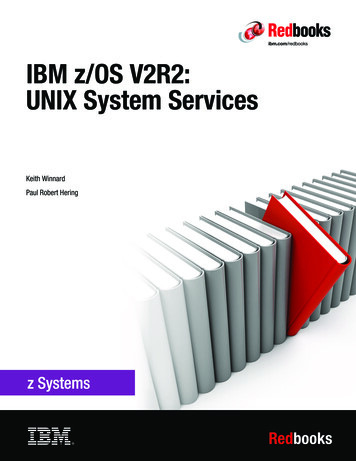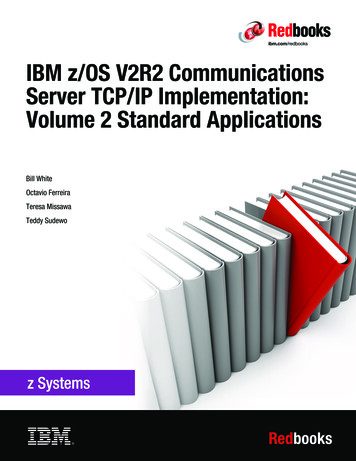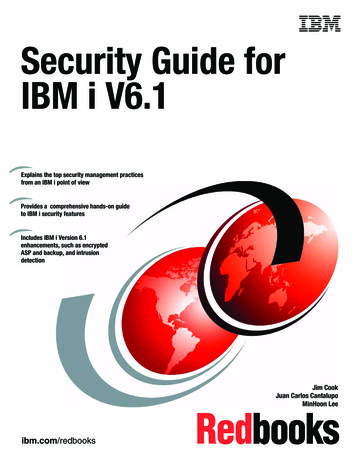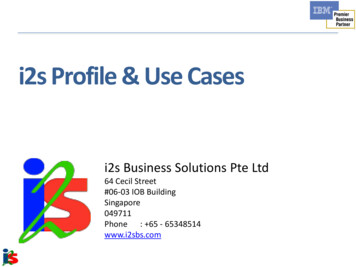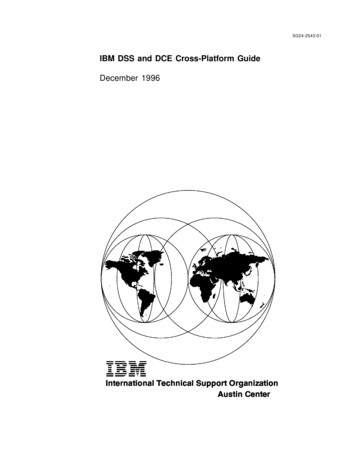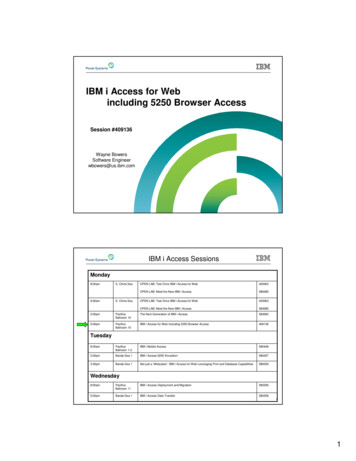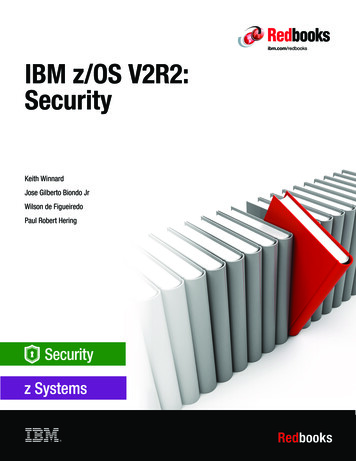
Transcription
Front coverIBM z/OS V2R2:SecurityKeith WinnardJose Gilberto Biondo JrWilson de FigueiredoPaul Robert HeringRedbooks
International Technical Support OrganizationIBM z/OS V2R2: SecurityDecember 2015SG24-8288-00
Note: Before using this information and the product it supports, read the information in “Notices” on page v.First Edition (December 2015)This edition applies to Version 2 Release 2 of IBM z/OS (5650-ZOS). Copyright International Business Machines Corporation 2015. All rights reserved.Note to U.S. Government Users Restricted Rights -- Use, duplication or disclosure restricted by GSA ADP ScheduleContract with IBM Corp.
ContentsNotices . . . . . . . . . . . . . . . . . . . . . . . . . . . . . . . . . . . . . . . . . . . . . . . . . . . . . . . . . . . . . . . . . .vTrademarks . . . . . . . . . . . . . . . . . . . . . . . . . . . . . . . . . . . . . . . . . . . . . . . . . . . . . . . . . . . . . . viIBM Redbooks promotions . . . . . . . . . . . . . . . . . . . . . . . . . . . . . . . . . . . . . . . . . . . . . . . . . viiPreface . . . . . . . . . . . . . . . . . . . . . . . . . . . . . . . . . . . . . . . . . . . . . . . . . . . . . . . . . . . . . . . . .Authors . . . . . . . . . . . . . . . . . . . . . . . . . . . . . . . . . . . . . . . . . . . . . . . . . . . . . . . . . . . . . . . . . .Now you can become a published author, too! . . . . . . . . . . . . . . . . . . . . . . . . . . . . . . . . . . .Comments welcome. . . . . . . . . . . . . . . . . . . . . . . . . . . . . . . . . . . . . . . . . . . . . . . . . . . . . . . .Stay connected to IBM Redbooks . . . . . . . . . . . . . . . . . . . . . . . . . . . . . . . . . . . . . . . . . . . . .ixixxixixiChapter 1. RACF updates . . . . . . . . . . . . . . . . . . . . . . . . . . . . . . . . . . . . . . . . . . . . . . . . . . 11.1 IBM Resource Access Control Facility . . . . . . . . . . . . . . . . . . . . . . . . . . . . . . . . . . . . . . 21.2 Read-only auditor attribute . . . . . . . . . . . . . . . . . . . . . . . . . . . . . . . . . . . . . . . . . . . . . . . 21.3 Password security enhancements . . . . . . . . . . . . . . . . . . . . . . . . . . . . . . . . . . . . . . . . . 21.3.1 Default password removal for ADDUSER. . . . . . . . . . . . . . . . . . . . . . . . . . . . . . . . 21.3.2 ICHDEX01 default change . . . . . . . . . . . . . . . . . . . . . . . . . . . . . . . . . . . . . . . . . . . 31.3.3 Password phrase support for RACLINK . . . . . . . . . . . . . . . . . . . . . . . . . . . . . . . . . 31.3.4 Default change for Health Check . . . . . . . . . . . . . . . . . . . . . . . . . . . . . . . . . . . . . . 41.4 RACDCERT - Granular certificate administration . . . . . . . . . . . . . . . . . . . . . . . . . . . . . . 41.5 UNIX search authority . . . . . . . . . . . . . . . . . . . . . . . . . . . . . . . . . . . . . . . . . . . . . . . . . . . 51.5.1 Directory search . . . . . . . . . . . . . . . . . . . . . . . . . . . . . . . . . . . . . . . . . . . . . . . . . . . 51.5.2 File running . . . . . . . . . . . . . . . . . . . . . . . . . . . . . . . . . . . . . . . . . . . . . . . . . . . . . . . 61.6 RACF remote sharing facility . . . . . . . . . . . . . . . . . . . . . . . . . . . . . . . . . . . . . . . . . . . . . 61.6.1 RRSF dynamic MAIN switching . . . . . . . . . . . . . . . . . . . . . . . . . . . . . . . . . . . . . . . 61.6.2 RACF – RRSF unidirectional connections . . . . . . . . . . . . . . . . . . . . . . . . . . . . . . 10Chapter 2. LDAP updates . . . . . . . . . . . . . . . . . . . . . . . . . . . . . . . . . . . . . . . . . . . . . . . . .2.1 Activity log enhancements . . . . . . . . . . . . . . . . . . . . . . . . . . . . . . . . . . . . . . . . . . . . . .2.1.1 Configuration file . . . . . . . . . . . . . . . . . . . . . . . . . . . . . . . . . . . . . . . . . . . . . . . . . .2.2 Compatibility level upgrade without LDAP outage . . . . . . . . . . . . . . . . . . . . . . . . . . . .2.2.1 New display commands . . . . . . . . . . . . . . . . . . . . . . . . . . . . . . . . . . . . . . . . . . .2.2.2 Migration and coexistence . . . . . . . . . . . . . . . . . . . . . . . . . . . . . . . . . . . . . . . . .2.3 Dynamic group performance enhancements . . . . . . . . . . . . . . . . . . . . . . . . . . . . . . . .2.3.1 Dynamic group suggestions . . . . . . . . . . . . . . . . . . . . . . . . . . . . . . . . . . . . . . .2.4 Replication of password policy attributes from a read-only replica . . . . . . . . . . . . . . . .2.4.1 Migration and coexistence . . . . . . . . . . . . . . . . . . . . . . . . . . . . . . . . . . . . . . . . .2.4.2 Benefit and value . . . . . . . . . . . . . . . . . . . . . . . . . . . . . . . . . . . . . . . . . . . . . . . .1314141516161718192020Chapter 3. PKI updates . . . . . . . . . . . . . . . . . . . . . . . . . . . . . . . . . . . . . . . . . . . . . . . . . . .3.1 Network Authentication Service PKINIT . . . . . . . . . . . . . . . . . . . . . . . . . . . . . . . . . . . .3.2 PKI NxM authorization . . . . . . . . . . . . . . . . . . . . . . . . . . . . . . . . . . . . . . . . . . . . . . . . .3.3 PKI OCSP enhancement . . . . . . . . . . . . . . . . . . . . . . . . . . . . . . . . . . . . . . . . . . . . . . .3.3.1 Usage and invocation . . . . . . . . . . . . . . . . . . . . . . . . . . . . . . . . . . . . . . . . . . . . . .3.4 RACDCERT - Granular certificate administration . . . . . . . . . . . . . . . . . . . . . . . . . . . . .3.4.1 Example 1: One profile for one function . . . . . . . . . . . . . . . . . . . . . . . . . . . . . . . .3.4.2 Example 2: One profile for multiple functions . . . . . . . . . . . . . . . . . . . . . . . . . . . .2122222424242525Chapter 4. z/OS UNIX search and file execution authority . . . . . . . . . . . . . . . . . . . . . . 27 Copyright IBM Corp. 2015. All rights reserved.iii
iv4.1 z/OS UNIX search authority . . . . . . . . . . . . . . . . . . . . . . . . . . . . . . . . . . . . . . . . . . . . .4.1.1 New UNIXPRIV profile . . . . . . . . . . . . . . . . . . . . . . . . . . . . . . . . . . . . . . . . . . . . .4.2 z/OS UNIX file execution. . . . . . . . . . . . . . . . . . . . . . . . . . . . . . . . . . . . . . . . . . . . . . . .4.2.1 New class FSEXEC . . . . . . . . . . . . . . . . . . . . . . . . . . . . . . . . . . . . . . . . . . . . . . .4.3 Examples for the use of the new functions . . . . . . . . . . . . . . . . . . . . . . . . . . . . . . . . . .4.3.1 Allowing a user to read entries in a UNIX directory and find entries . . . . . . . . . . .4.3.2 Controlling file execution . . . . . . . . . . . . . . . . . . . . . . . . . . . . . . . . . . . . . . . . . . . .28282828292930Related publications . . . . . . . . . . . . . . . . . . . . . . . . . . . . . . . . . . . . . . . . . . . . . . . . . . . . .IBM Redbooks . . . . . . . . . . . . . . . . . . . . . . . . . . . . . . . . . . . . . . . . . . . . . . . . . . . . . . . . . . .Other publications . . . . . . . . . . . . . . . . . . . . . . . . . . . . . . . . . . . . . . . . . . . . . . . . . . . . . . . .Help from IBM . . . . . . . . . . . . . . . . . . . . . . . . . . . . . . . . . . . . . . . . . . . . . . . . . . . . . . . . . . .33333333IBM z/OS V2R2: Security
NoticesThis information was developed for products and services offered in the U.S.A.IBM may not offer the products, services, or features discussed in this document in other countries. Consultyour local IBM representative for information on the products and services currently available in your area. Anyreference to an IBM product, program, or service is not intended to state or imply that only that IBM product,program, or service may be used. Any functionally equivalent product, program, or service that does notinfringe any IBM intellectual property right may be used instead. However, it is the user's responsibility toevaluate and verify the operation of any non-IBM product, program, or service.IBM may have patents or pending patent applications covering subject matter described in this document. Thefurnishing of this document does not grant you any license to these patents. You can send license inquiries, inwriting, to:IBM Director of Licensing, IBM Corporation, North Castle Drive, Armonk, NY 10504-1785 U.S.A.The following paragraph does not apply to the United Kingdom or any other country where suchprovisions are inconsistent with local law: INTERNATIONAL BUSINESS MACHINES CORPORATIONPROVIDES THIS PUBLICATION "AS IS" WITHOUT WARRANTY OF ANY KIND, EITHER EXPRESS ORIMPLIED, INCLUDING, BUT NOT LIMITED TO, THE IMPLIED WARRANTIES OF NON-INFRINGEMENT,MERCHANTABILITY OR FITNESS FOR A PARTICULAR PURPOSE. Some states do not allow disclaimer ofexpress or implied warranties in certain transactions, therefore, this statement may not apply to you.This information could include technical inaccuracies or typographical errors. Changes are periodically madeto the information herein; these changes will be incorporated in new editions of the publication. IBM may makeimprovements and/or changes in the product(s) and/or the program(s) described in this publication at any timewithout notice.Any references in this information to non-IBM websites are provided for convenience only and do not in anymanner serve as an endorsement of those websites. The materials at those websites are not part of thematerials for this IBM product and use of those websites is at your own risk.IBM may use or distribute any of the information you supply in any way it believes appropriate without incurringany obligation to you.Any performance data contained herein was determined in a controlled environment. Therefore, the resultsobtained in other operating environments may vary significantly. Some measurements may have been madeon development-level systems and there is no guarantee that these measurements will be the same ongenerally available systems. Furthermore, some measurements may have been estimated throughextrapolation. Actual results may vary. Users of this document should verify the applicable data for theirspecific environment.Information concerning non-IBM products was obtained from the suppliers of those products, their publishedannouncements or other publicly available sources. IBM has not tested those products and cannot confirm theaccuracy of performance, compatibility or any other claims related to non-IBM products. Questions on thecapabilities of non-IBM products should be addressed to the suppliers of those products.This information contains examples of data and reports used in daily business operations. To illustrate themas completely as possible, the examples include the names of individuals, companies, brands, and products.All of these names are fictitious and any similarity to the names and addresses used by an actual businessenterprise is entirely coincidental.COPYRIGHT LICENSE:This information contains sample application programs in source language, which illustrate programmingtechniques on various operating platforms. You may copy, modify, and distribute these sample programs inany form without payment to IBM, for the purposes of developing, using, marketing or distributing applicationprograms conforming to the application programming interface for the operating platform for which the sampleprograms are written. These examples have not been thoroughly tested under all conditions. IBM, therefore,cannot guarantee or imply reliability, serviceability, or function of these programs. Copyright IBM Corp. 2015. All rights reserved.v
TrademarksIBM, the IBM logo, and ibm.com are trademarks or registered trademarks of International Business MachinesCorporation in the United States, other countries, or both. These and other IBM trademarked terms aremarked on their first occurrence in this information with the appropriate symbol ( or ), indicating USregistered or common law trademarks owned by IBM at the time this information was published. Suchtrademarks may also be registered or common law trademarks in other countries. A current list of IBMtrademarks is available on the Web at http://www.ibm.com/legal/copytrade.shtmlThe following terms are trademarks of the International Business Machines Corporation in the United States,other countries, or both:DB2 IBM OS/390 Parallel Sysplex RACF Redbooks Redbooks (logo)Tivoli z/OS z/VM The following terms are trademarks of other companies:UNIX is a registered trademark of The Open Group in the United States and other countries.Other company, product, or service names may be trademarks or service marks of others.viIBM z/OS V2R2: Security
IBM REDBOOKS PROMOTIONSIBM Redbooks promotionsFind and read thousands ofIBM Redbooks publicationsSearch, bookmark, save and organize favoritesGet up-to-the-minute Redbooks news and announcementsLink to the latest Redbooks blogs and videosDownloadNowAndroidiOSGet the latest version of the Redbooks Mobile AppPromote your businessin an IBM Redbookspublication Place a Sponsorship Promotion in an IBMRedbooks publication, featuring your businessor solution with a link to your web site. Qualified IBM Business Partners may place a full pagepromotion in the most popular Redbooks publications.Imagine the power of being seen by users who downloadmillions of Redbooks publications each year!ibm.com/RedbooksAbout RedbooksBusiness Partner Programs
THIS PAGE INTENTIONALLY LEFT BLANK
PrefaceThis IBM Redbooks publication helps you to become familiar with the technical changesthat were introduced to the security areas with IBM z/OS V2R2.The following chapters are included: Chapter 1, “RACF updates” on page 1In this chapter, we describe the read-only auditor attribute, password securityenhancements, RACDCERT (granular certificate administration), UNIX search authority,and RACF Remote sharing facility (RRSF). Chapter 2, “LDAP updates” on page 13In this chapter, we describe the activity log enhancements, compatibility level upgradewithout LDAP outage, dynamic group performance enhancements, and replication ofpassword policy attributes from a read-only replica. Chapter 3, “PKI updates” on page 21In this chapter, we describe the Network Authentication Service (KERBEROS) PKINIT,PKI nxm authorization, PKI OCSP enhancement, and RACDCERT (granular certificateadministration) Chapter 4, “z/OS UNIX search and file execution authority” on page 27z/OS UNIX search authority, z/OS UNIX file execution, Examples for exploiting the newfunctionsThis book is one of a series of IBM Redbooks publications that take a modular approach toproviding information about the updates that are included with z/OS V2R2. This approach hasthe following goals: Provide modular content Group the technical changes into a topic Provide a more streamlined way of finding relevant information that is based on the topicWe hope you find this approach useful and we welcome your feedback.AuthorsThis book was produced by a team of specialists from around the world working at theInternational Technical Support Organization, Poughkeepsie Center.Keith Winnard is the z/OS Project Leader at the International Technical SupportOrganization, Poughkeepsie Center. He writes extensively and is keen to engage withcustomers to understand what they want from IBM Redbooks Publications. Before joining theITSO in 2014, Keith worked for clients and Business Partners in the UK and Europe in varioustechnical and account management roles. He is experienced with blending and integratingnew technologies into the traditional landscape of mainframes. Copyright IBM Corp. 2015. All rights reserved.ix
Jose Gilberto Biondo Jr is an IT Specialist in Integrated Technology Delivery,ServerSystems Operations/Storage Management in IBM Brazil. He has seven years ofexperience in z/OS, working with storage management since 2007. Jose works mainly withIBM storage products (DFSMSdfp, DFSMSdss, DFSMShsm, and DFSMSrmm), but he alsoworks with OEM software products. Jose’s areas of expertise include installing andmaintaining storage products and process automation.Wilson de Figueiredo is z/OS System Programmer. He manages the operations supportteam at Banco do Brasil, a government bank in Brazil. He has more than 11 years ofexperience in mainframe systems. He holds system analysis, internet consulting andbusiness administration degrees. His areas of expertise include IBM Parallel Sysplex , z/OSsecurity, and z/OS availability.Paul Robert Hering is an IT Specialist at the ITS Technical Support Center, Mainz, Germany.He provides support to clients with z/OS and z/OS UNIX-related questions and problems. Hehas participated in several ITSO residencies since 1988, writing about UNIX-related topics.Before supporting the IBM OS/390 and z/OS, Robert worked for many years with the IBMVM operating system and its variations (VM/370, VM/HPO, VM/XA, and VM/ESA).Thanks to the following people for their contributions to this project:Bob Haimowitz (Development Support Team [DST], Poughkeepsie Center) for setting upand maintaining the systems, and providing valuable advice, guidance, and assistancethroughout the creation of this IBM Redbooks publication.Rich Conway (DST, Poughkeepsie Center) for setting up and maintaining the systems, andproviding valuable advice, guidance, and assistance throughout the creation of this IBMRedbooks publication.Peter Bertolozzi (Systems Management specialist, IBM Redbooks residency support,Poughkeepsie Center) for setting up and maintaining the environments in which the residentsworked.John Gierloff (Operations, Poughkeepsie Center) for residency setup and support.Don Brennan (DST, Poughkeepsie Center) for setting up and maintaining the systemshardware that was used in the creation of this IBM Redbooks publication.Ella Buslovich (Graphics specialist, Poughkeepsie Center) for providing graphical guidancefor this IBM Redbooks publication.Ann Lund (ITSO Administration, Poughkeepsie Center) for administrative support to enablethe residency.xIBM z/OS V2R2: Security
Now you can become a published author, too!Here’s an opportunity to spotlight your skills, grow your career, and become a publishedauthor—all at the same time! Join an ITSO residency project and help write a book in yourarea of expertise, while honing your experience using leading-edge technologies. Your effortswill help to increase product acceptance and customer satisfaction, as you expand yournetwork of technical contacts and relationships. Residencies run from two to six weeks inlength, and you can participate either in person or as a remote resident working from yourhome base.Find out more about the residency program, browse the residency index, and apply online at:ibm.com/redbooks/residencies.htmlComments welcomeYour comments are important to us!We want our books to be as helpful as possible. Send us your comments about this book orother IBM Redbooks publications in one of the following ways: Use the online Contact us review Redbooks form found at:ibm.com/redbooks Send your comments in an email to:redbooks@us.ibm.com Mail your comments to:IBM Corporation, International Technical Support OrganizationDept. HYTD Mail Station P0992455 South RoadPoughkeepsie, NY 12601-5400Stay connected to IBM Redbooks Find us on Facebook:http://www.facebook.com/IBMRedbooks Follow us on Twitter:http://twitter.com/ibmredbooks Look for us on LinkedIn:http://www.linkedin.com/groups?home &gid 2130806 Explore new Redbooks publications, residencies, and workshops with the IBM Redbooksweekly sf/subscribe?OpenForm Stay current on recent Redbooks publications with RSS i
xiiIBM z/OS V2R2: Security
1Chapter 1.RACF updatesIn this chapter, we describe the changes that were introduced with z/OS V2R2 to IBMRACF .This chapter includes the following topics: 1.1, “IBM Resource Access Control Facility” on page 21.2, “Read-only auditor attribute” on page 21.3, “Password security enhancements” on page 21.4, “RACDCERT - Granular certificate administration” on page 41.5, “UNIX search authority” on page 51.6, “RACF remote sharing facility” on page 6 Copyright IBM Corp. 2015. All rights reserved.1
1.1 IBM Resource Access Control FacilityThe IBM Resource Access Control Facility (RACF) is a security system that provides accesscontrol and auditing functions for the z/OS and IBM z/VM operating systems. It establishessecurity policies rather than only permission records and can set them for file patterns, whichallows access through identification, classification, and protection of system resources.RACF with z/OS V2R2 includes the following enhancements: Read-only auditor attributePassword security enhancementsRACDCERT - Granular certificate administrationUNIX search authorityRACF remote sharing facility1.2 Read-only auditor attributeAs shown in Example 1-1, the new RACF user attribute Read-Only Auditor (ROAUDIT) allowsusers to list profiles and users and permit the same ability to list information that is allowed tousers with the AUDITOR attribute, but not alter any system controls. It is suitable for internaland external auditors.Example 1-1 Creating and displaying a user with ROAUDIT optionADDUSER DIANA ROAUDIT TSO(PROC(ISPFPROC).) .READYLISTUSER DIANAUSER DIANA NAME DIANA FRIENDLY OWNER IBMUSER CREATED 15.112DEFAULT-GROUP SYS1 PASSDATE 00.000 PASS-INTERVAL 30 PHRASEDATE N/AATTRIBUTES ROAUDITREVOKE DATE NONE RESUME DATE NONELAST-ACCESS UNKNOWNCLASS AUTHORIZATIONS NONENO-INSTALLATION-DATANO-MODEL-NAMELOGON ALLOWED (DAYS) -1.3 Password security enhancementsz/OS V2R2 introduces some new enhancements that are related to password security, asdescribed in this section.1.3.1 Default password removal for ADDUSERWhen the ADDUSER command is issued in RACF without the PASSWORD operand, the userpassword defaults to the name of the default group. If the administrator forgets to change thepassword in a timely manner, the password represents a value that can be guessed and usedto log on to the user.2IBM z/OS V2R2: Security
The ADDUSER command no longer assigns a default password. If no phrase is specified, theuser is defined as PROTECTED.When the new default results in a PROTECTED user, the new informational message that isshown in Example 1-2 is issued.Example 1-2 Add new user without a passwordADDUSER NEWUSERICH01024I User NEWUSER is defined as PROTECTED.The following message is suppressed if NOPASSWORD is specified:AU NEWUSER NOPASSWORDThere is no message to indicate the lack of a password if a phrase is specified, as shown inthe following example:AU NEWUSER PHRASE('RACF rocks')1.3.2 ICHDEX01 default changeThe RACF exit ICHDEX01 is no longer needed unless you are implementing your ownencryption. In the absence of the exit routine, the RACF default password evaluation behavioris to attempt to first assume the Data Encryption Standard (DES). If no match is found,masking is used.Since November 12, 2014, via OA43998 (SAF) and OA43999 (RACF), IBM encourages theadoption of the new Key Defined Function AES (KDFAES) strong password and passwordphrase algorithm, in which masking is no longer used.1.3.3 Password phrase support for RACLINKThe RACLINK DEFINE command now supports password phrases. APAR OA43999 allowedphrase-only users, but the RACLINK DEFINE command did not support phrases.The RACLINK DEFINE command allows specification of target user's password/phrase forimplicit approval of the user ID association:RACLINK ID(thisuser) DEFINE(thatnode.thatuser/thatpwd) PEER(PWSYNC)Enclose the entire node.user or phrase string in single quotation marks if the followingconditions are present: The phrase starts with “*”. Otherwise, TSO treats “/*” as a comment and ignores the rest ofthe command. The phrase contains a space. Otherwise, TSO treats the text after the space as anothernode.userid string.Consider the following examples:RACLINK DEFINE('NODE2.USER2/*This is my phrase') PEER(PWSYNC)RACLINK DEFINE('NODE3.USER3/*This is your phrase' 'NODE4.USER4/*This is hisphrase') PEER(PWSYNC)Chapter 1. RACF updates3
1.3.4 Default change for Health CheckThe RACF ENCRYPTION ALGORITHM Health Check raises an exception if KDFAES is notthe active algorithm. It is suggested that with V2R2, KDFAES should be considered thedesirable or required algorithm.1.4 RACDCERT - Granular certificate administrationThe RACDCERT command that is used to install and maintain digital certificates, key rings, anddigital certificate mappings in RACF. Use this command for all profile maintenance in theDIGTCERT, DIGTRING, and DIGTMAP classes.Certificate and key ring administration in RACF are handled by the RACDCERT command. Itsfunctions access is controlled by the FACILITY class, through the IRR.DIGTCERT. racdcertfunction (for example, ADD and DELETE) profiles.The access that is needed is based on the ownership of the following certificates or key rings: READ to act on your own UPDATE to act on other’s CONTROL to act on CERTAUTH/SITEThis access model is “none” or “all”, and there is no granular control. When you haveCONTROL access to IRR.DIGTCERT.GENCERT, you can generate any certificate authority(CA) certificates.z/OS V2R2 EnhancementsThe certificate and key ring administration can be more granular after you turn it on by thepresence of the profile IRR.RACDCERT.GRANULAR in the RDATALIB class. Then, grant atleast READ access, depending on whether a certificate, ring, or both are involved. Granularcontrol is applicable to the following functions: ETEEXPORTGENCERTGENREQIMPORTREKEYROLLOVER Ring:– ADDRING– DELRING Certificate and ring:– CONNECT– REMOVEWhen granular control is turned on, one or both types of the following profiles in theRDATALIB class are checked for READ access, depending on whether a certificate, ring, orboth are involved. Only READ access to the resource is required now. RACF checks differentresources based on the resource affected (certificate, ring, or both).4IBM z/OS V2R2: Security
The following standards are used for each resource: Certificates: IRR.DIGTCERT. cert owner . cert label .UPD. racdcert cert functions ,where:– 'cert owner' is the RACF user ID, CERTIFAUTH for certificate that is owned byCERTAUTH, or SITECERTIF for certificate that is owned by SITE– cert label is the certificate label– racdcert cert functions is the function request Key rings: ring owner . ring name .UPD. ADDRING or DELRING , where:– 'ring owner' is the RACF user ID, CERTIFAUTH for certificate that is owned byCERTAUTH, or SITECERTIF for certificate that is owned by SITE– Ring label is the key ring label– ADDRING or DELRING is the function that is performed Certificates key rings: Both profiles are checkedExample 1-3 shows a profile to control who can delete the certificate with labelFTPSERVER1 that is owned by user ID ftpid and allow USERA to delete the certificate.Example 1-3 Define RACF resource for certificate FTPSERVER1RDEFINE RDATALIB IRR.DIGTCERT.FTPID.FTPSERVER1.UPD.DELETE UACC(NONE)PERMIT IRR.DIGTCERT.FTPID.FTPSERVER1.UPD.DELETE CLASS(RDATALIB) ID(USERA)ACCESS(READ)This change enables you to segregate RACDCERT authorities among the administrators andenforce a naming convention for naming the certificates and key rings.1.5 UNIX search authorityThe following new controls are available over z/OS UNIX System Services authorization.These controls are implemented in the ck access callable service (IRRSKA00) and allowgeneric names in the UNIXPRIV class in RACF: Allow directory search (DIRSRCH) Deny file execution (FSEXEC)1.5.1 Directory searchBy using UNIX SEARCH DIRECTORY, users can read and search all file system directories,regardless of individual directory settings. Previous to z/OS V2R2, it was necessary to grantREAD and SEARCH to all directories or grant a higher-than-wanted authority, such asAUDITOR, BPX.SUPERUSER profile in the FACILITY class, or uid 0.Resources SUPERUSER.FILESYS.CHANGEPERMS and CHOWN delegated UNIX securityadministration in the UNIXPRIV class did not allow those specific accesses.The new UNIXPRIV resource SUPERUSER.FILESYS.DIRSRCH controls read and searchaccess to all directories in RACF. At least READ permission must be granted to obtain accessto UNIX directories.Chapter 1. RACF updates5
Create the profile in the UNIXPRIV class in RACF, as shown in the following example:RDEFINE UNIXPRIV SUPERUSER.FILESYS.DIRSRCH UACC(NONE)Grant access to a user or group as shown in the following example:PERMIT SUPERUSER.FILESYS.DIRSRCH CLASS(UNIXPRIV) ID(IBMUSER) ACCESS(READ)SETROPTS RACLIST(UNIXPRIV) REFRESHNote: DIRSRCH authority does not grant read, write, or run permission to ordinary UNIXfiles. It also does not grant write permission to UNIX directories.z/OS V2R2 provides a more granular mechanism to delegate UNIX security administration,reduces the number of administrators who require superuser or auditor authorization, andavoids over-authorization.1.5.2 File runningThe new FSEXEC class in RACF prevents running a specific file system or all files in a filesystem, similar to a NOEXEC mount option. It is supported for ZFS and TFS file systems anddoes not apply to file systems that are mounted with the -s nosecurity option.The profile name in the FSEXEC class is case-sensitive and must match the name that isspecified in the MOUNT statement that is used in the parameter library.Define a profile in the FSEXEC class, granting at least UPDATE access, as shown in thefollowing example:RDEFINE FSEXEC OMVS.ZFS.ADMIN.** UACC(NONE)Grant access to a user or group, as shown in the following example:PERMIT EC)ID(IBMUSER) ACCESS(UPDATE)REFRESHNote: When a file system is protected by an FSEXEC profile and a user has insufficientaccess to it, RACF denies the file running access, regardless of other user authorization.Additionally, superuser or auditor privileges do not override FSEXEC denial of access.1.6 RA
Get the latest version of the Redbooks Mobile App iOS Android Place a Sponsorship Promotion in an IBM Redbooks publication, featuring your business or solution with a link to your web site. Qualified IBM Business Partners may place a full page promotion in the most popular Redbooks publications.
